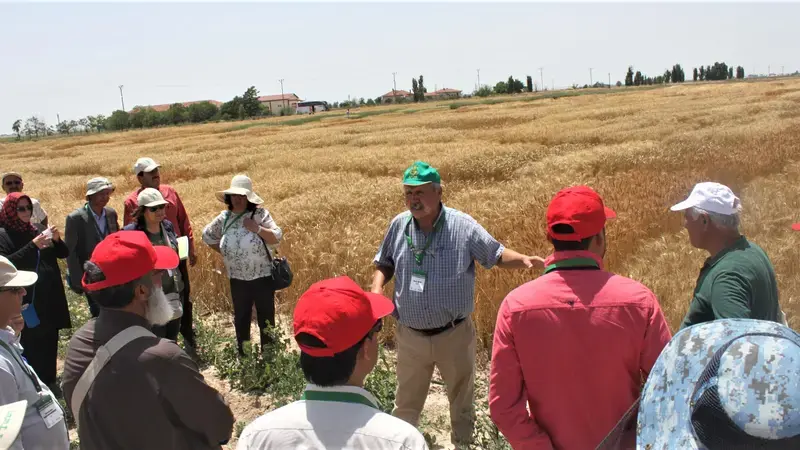Traveling seminar through the wheat fields of Turkey

Turkey – In June, about 50 crop scientists gathered in the wheat fields of Turkey. The group, representing no fewer than 11 countries, offered global technical expertise on and insights into wheat as a crop in drylands. Their goal: learn more about improved winter wheat varieties.
Organized by the International Winter Wheat Improvement Program, or IWWIP, the event – traveling seminar and phenotyping exercise – was a scientific roadshow. The delegation of scientists came from far and near, with 27 from Turkey, and the rest from Azerbaijan, China, Pakistan, Russia, Turkmenistan, South Korea, Spain, and the United Kingdom.
“This is a unique opportunity to share experiences from East to West and discover the latest findings in genotypes,” says Keser Mesut, ICARDA’s senior scientist and country manager based out of Ankara, Turkey. “Having the opportunity to share wheat improvement activities is extremely important. It helps us understand that our needs are shaped by similar challenges posed by climate change.”
IWWIP is a joint program between the Turkish Ministry of Food, Agriculture, and Livestock, the International Maize and Wheat Improvement Center, widely known as CIMMYT, and ICARDA.
Established in the mid-1980s by Turkey and CIMMYT to breed winter wheat, the IWWIP alliance has expanded over the years with ICARDA joining in 1991. The aim is to develop winter and facultative wheat germplasm for North Africa, Central, and West Asia, and facilitate their exchange.
Starting out in the capital, the group first visited winter wheat trial sites and pathology fields located at the research station in Haymana, district of Ankara province. Turkey’s Central Research Institute for Field Crops showed them its wheat cultivars in demo plots. From Haymana, the roadshow took the scientists to key breeding sites showcasing IWWIP’s wheat improvement activities.
“I was amazed to see that there is such a vast diversity in wheat that I never thought of,” said Kyeongmin Kim, one of the two South Korean scientists. South Korea is traditionally not a wheat-growing country, but it is making new efforts to promote the crop.
“I want to take all the wheat in the sites to my country and test them there to help my farmers,” said Guljamal Taylakova from Turkmenistan.
For participants from Pakistan, this traveling seminar turned out to be a relevant and meaningful discovery because of the country’s need for new winter wheat germplasm suitable for rainfed farming.
In the historical province of Eskisehir – which means “old city” – in northwestern Turkey, the Transitional Zone Agricultural Research Institute welcomed the scientists. Here they visited wheat rainfed trial sites and selected samples that could be suitable back home.
Later on in Konya, a city south of Ankara in the Central Anatolia region, the group saw wheat, barley, oat, triticale, and rye cultivars grown by representatives from the Bahri Dagdas International Agricultural Research Institute. Konya is one of IWWIP’s key breeding sites with trove of studies and materials for agricultural development in drylands across the world: rainfed and irrigated yield trials; synthetic wheat studies; wheat landrace; drought studies; and vernalization studies (the cooling of seed during germination to accelerate flowering once it’s planted).
Throughout the tour, the participants worked together on phenotyping exercises and learned about the application of remote-sensing techniques and phenotyping tools. In fact, it was a two-day wheat phenotyping workshop in Konya that completed the trip.
“What makes this visit special is that we see the trials together and can exchange views with each other,” said Malakmassoud Ahmadi from Iran’s Dryland Agricultural Research Institute. “It is not important to agree on one solution or a particular statement. The most important thing is to hear different views on the same subjects to broaden our knowledge,” he added.
Keser Mesut is a senior scientist and ICARDA country manager in Turkey.
